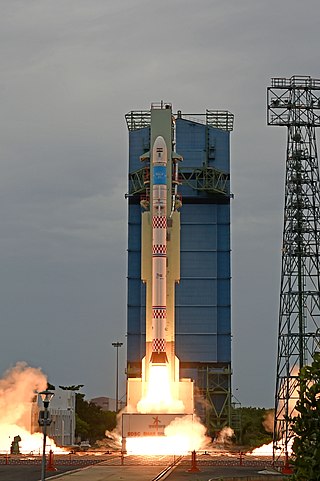India's remote sensing program was developed with the idea of applying space technologies for the benefit of humankind and the development of the country. The program involved the development of three principal capabilities. The first was to design, build and launch satellites to a Sun-synchronous orbit. The second was to establish and operate ground stations for spacecraft control, data transfer along with data processing and archival. The third was to use the data obtained for various applications on the ground.
A scatterometer or diffusionmeter is a scientific instrument to measure the return of a beam of light or radar waves scattered by diffusion in a medium such as air. Diffusionmeters using visible light are found in airports or along roads to measure horizontal visibility. Radar scatterometers use radio or microwaves to determine the normalized radar cross section of a surface. They are often mounted on weather satellites to find wind speed and direction, and are used in industries to analyze the roughness of surfaces.

The NASA QuikSCAT was an Earth observation satellite carrying the SeaWinds scatterometer. Its primary mission was to measure the surface wind speed and direction over the ice-free global oceans via its effect on water waves. Observations from QuikSCAT had a wide array of applications, and contributed to climatological studies, weather forecasting, meteorology, oceanographic research, marine safety, commercial fishing, tracking large icebergs, and studies of land and sea ice, among others. This SeaWinds scatterometer is referred to as the QuikSCAT scatterometer to distinguish it from the nearly identical SeaWinds scatterometer flown on the ADEOS-2 satellite.

Oceansat-2 is the second Indian satellite built primarily for ocean applications. It was a part of the Indian Remote Sensing Programme satellite series. Oceansat-2 is an Indian satellite designed to provide service continuity for operational users of the Ocean Colour Monitor (OCM) instrument on Oceansat-1. It will also enhance the potential of applications in other areas. The OceanSat-2 mission was approved by the government of India on 16 July 2005.

Radar Imaging Satellite 1 or RISAT-1, was an Indian remote sensing satellite built and operated by the Indian Space Research Organisation (ISRO). The second RISAT satellite to be launched, it used a C-band 5.35 GHz synthetic-aperture radar (SAR) for Earth observation.

SRMSAT is a Nanosatellite built by students at Sri Ramaswamy Memorial University in India. The satellite is an Indian Technology demonstration and Earth observation satellite which is operated by the SRM Institute of Science and Technology. This nanosatellite was used to monitor Greenhouse gases in atmosphere.
Oceansat-1 or IRS-P4 was the first Indian satellite built primarily for ocean applications. It was a part of the Indian Remote Sensing Programme satellite series. The satellite carried an Ocean Colour Monitor (OCM) and a Multi-frequency Scanning Microwave Radiometer (MSMR) for oceanographic studies. Oceansat-1 thus vastly augment the IRS satellite system of Indian Space Research Organisation (ISRO) comprising four satellites, IRS-1B, IRS-1C, IRS-P3 and IRS-1D and extend remote sensing applications to several newer areas.

Aluru Seelin Kiran Kumar is an Indian space scientist and former chairman of the Indian Space Research Organisation, having assumed office on 14 January 2015. He is credited with the development of key scientific instruments aboard the Chandrayaan-1 and Mangalyaan space crafts. In 2014, he was awarded the Padma Shri, India's fourth highest civilian award, for his contributions to the fields of science and technology. Kiran Kumar previously served as Director of Ahmedabad Space Applications Centre.
Cartosat-2C is an Earth observation satellite in a Sun-synchronous orbit (SSO) and is a fifth flight unit of Cartosat series of satellites. It is a geostationary satellite and appears stationary over a place on the earth. The satellite is built at space application centre Ahmedabad, launched and maintained by the Indian Space Research Organisation (ISRO). It was launched on 22 June 2016.

EOS-04 or Earth Observation Satellite - 04 is an Indian Space Research Organisation Radar Imaging Satellite designed to provide high quality images under all weather conditions for applications such as Agriculture, Forestry & Plantations, Soil Moisture & Hydrology and Flood mapping. It is a follow on to RISAT-1 satellite with similar configuration. The satellite is developed by the ISRO and it is sixth in series of RISAT satellites.
PSLV-C35 was the successful mission of the Polar Satellite Launch Vehicle program which set eight satellites in space. It was launched on 26 September 2016 by Indian Space Research Organisation (ISRO) from the Satish Dhawan Space Centre at Sriharikota.
PSLV-C2 was the second operational launch and overall fifth mission of the Polar Satellite Launch Vehicle (PSLV) program. This launch was also the forty-third launch by Indian Space Research Organisation (ISRO) since its first mission on 1 January 1962. The vehicle carried three satellites which were deployed in the Sun-synchronous low Earth orbit. The vehicle carried India's first remote sensing satellite Oceansat-1 (IRS-P4) as the main payload. It also carried South Korean satellite KITSAT-3 and German satellite DLR-Tubsat as auxiliary payloads. PSLV-C2 was the first Indian Expendable launch vehicle to carry and deploy more than one satellite in a mission. This was also India's and ISRO's first commercial spaceflight where South Korea and Germany each paid US$1.0 million to ISRO for launching their satellites.
Alsat-1B is an Algerian satellite operated by the Agence Spatiale Algerienne for agricultural and disaster monitoring. The contract for the mission was signed in July 2014. The satellite is based on the SSTL-100 bus. The satellite weighs 103 kilograms (227 lb) and carries an earth imaging payload with 12-metre (39 ft) panchromatic imager and 24-metre (79 ft) multispectral cameras.

ISS-RapidScat was an instrument mounted to the International Space Station'sColumbus module that measured wind speeds. It was launched aboard SpaceX CRS-4 in September 2014 and operated until August 2016. ISS-RapidScat was a scatterometer designed to support weather forecasting by bouncing microwaves off the ocean's surface to measure wind speed via wind waves. It featured a 75 cm (30 in) rotating radar dish that operated at 13.4 GHz. It could collect data between 51.6 degrees north and south latitude, with a swath 900 km wide (560 mi).

PSLV-C37 was the 39th mission of the Indian Polar Satellite Launch Vehicle (PSLV) program and its 16th mission in the XL configuration undertaken by the Indian Space Research Organisation (ISRO). Launched on 15 February 2017 from the Satish Dhawan Space Centre at Sriharikota, Andhra Pradesh, the rocket successfully carried and deployed a record number of 104 satellites in sun-synchronous orbits in a single mission, breaking the earlier record of launching 37 satellites by a Russian Dnepr rocket on 19 June 2014. This record was held until the launch of the Transporter-1 mission by SpaceX on 24 January 2021 which launched 143 satellites.

The Small Satellite Launch Vehicle (SSLV) is a small-lift launch vehicle developed by ISRO with payload capacity to deliver 500 kg (1,100 lb) to low Earth orbit or 300 kg (660 lb) to Sun-synchronous orbit for launching small satellites, with the capability to support multiple orbital drop-offs. SSLV is made keeping low cost, low turnaround time in mind with launch-on-demand flexibility under minimal infrastructure requirements.
Oceansat is a series of earth observation satellites built, launched, and operated by Indian Space Research Organisation, and dedicated to oceanography and atmospheric studies. Oceansat satellites facilitate a range of applications including documenting chlorophyll concentration, phytoplankton blooms, atmospheric aerosols and particulate matter as well as marine weather forecast to predict cyclones.










